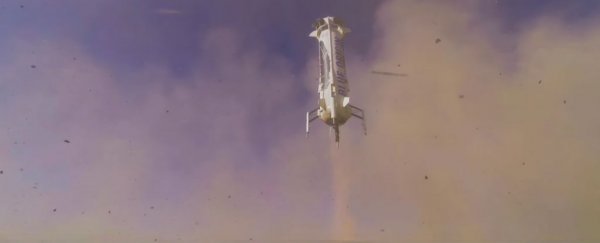On Friday 22 January, billionaire Amazon founder Jeff Bezos's private space company, Blue Origin, managed to successfully launch and land its New Shephard reusable rocket for the second time, making history as the first team to successfully land the same rocket twice. While New Shephard is not yet capable of completing missions out in orbit, this and its previous landing back in November are proof that the future of spaceflight will be built on reusable rockets. And that means getting humans further into space than ever before.
"Our vision: millions of people living and working in space," says Blue Origin in the video of the landing above. "You can't get there by throwing the hardware away."
According to the Bezos, the New Shephard single stage rocket booster launched from the company's West Texas launch site, cleared the tower, and reached an altitude of 101.7 km (333,582 feet). This altitude is important, because it means the rocket is capable of clearing the Karman line at 100 km above sea level - the official boundary between Earth's atmosphere and outer space.
Not only did New Shephard get slightly higher into space than its previous effort, but Bezos told Business Insider that this time the Blue Origin engineers managed to integrate new software that allows the rocket to target its landing point from much farther away than last time.
This means that, just like aeroplane pilots account for drift when they're landing and try to make the safest - not necessarily most centred - landing on the runway, New Shephard has now been programmed to land off-centre on the landing pad if conditions require it. "This new strategy increases margins, improving the vehicle's ability to reject disturbances created by low-altitude winds," says Bezos.
Bezos adds that the landing is a proof of concept that they could use a similar system to launch much larger space vehicles in the coming years. According to David Szondy at Gizmag, details of a family of orbital launch vehicles much larger than New Shepard are expected to be released by Blue Origin later this year.
"Though wings and parachutes have their adherents and their advantage, I'm a huge fan of rocket-powered vertical landing," Bezos wrote on the Blue Origin website.
"Why? Because to achieve our vision of millions of people living and working in space, we will need to build very large rocket boosters. And the vertical landing architecture scales extraordinarily well. When you do a vertical landing, you're solving the classic inverted pendulum problem, and the inverted pendulum problem gets a bit easier as the pendulum gets a bit bigger."
While it's tempting to pit Blue Origin and SpaceX against each other because they both happen to be testing out reusable rocket landings at exactly the same time, the two US-based companies are actually doing very different things. On the one hand, SpaceX is trying to land its reusable rocket after successfully completing actual missions to the International Space Station (ISS), and on the other, landing reusable rockets is all Blue Origin is trying to do right now - its rocket isn't getting anywhere near the ISS.
"[Back in November], SpaceX's Elon Musk gave Blue Origin's Jeff Bezos grief (mixed with congratulations) that getting to space wasn't the same as orbital spaceflight," says Mika McKinnon at Gizmodo. "He legitimately emphasised that what he was doing with SpaceX and the Falcon 9 was in a totally different class. SpaceX pulled off its own first post-mission vertical landing a month later, delivering a Falcon 9 rocket to Cape Canaveral in Florida."
Space race or no space race, what's exciting here is that there are two legitimately awesome companies making real progress on their respective spaceflight technologies, and that's a win-win situation for everyone. We have a feeling 2016 is going to be an unforgettable year for rocket science.
